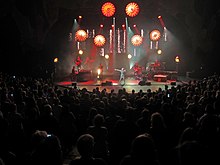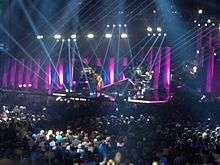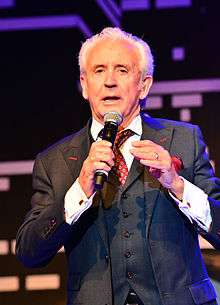Schlager music
Schlager music (German: [ˈʃlaːɡɐ], "hit(s)")[2] is a style of European popular music that is generally a catchy instrumental accompaniment to vocal pieces of pop music with simple, happy-go-lucky, and often sentimental lyrics. It is prevalent in Central, Northern and Southeast Europe (in particular Germany,[2] Austria, Albania, Bulgaria, Finland, Slovenia, Serbia, Croatia, Poland, Hungary, Romania, Switzerland, Scandinavia, and the Baltic states), and also (to a lesser extent) in France, Belgium, the Netherlands, and the UK. In the United States it is also known as 'entertainer music' or 'German hit mix'.

| Schlager | |
|---|---|
| Stylistic origins | |
| Cultural origins | 1950s, East Germany and West Germany[1] |
| Typical instruments | |
| Subgenres | |
| Dansband | |
| Regional scenes | |
| Other topics | |
| Music of Germany | |
Typical schlager tracks are either sweet, sentimental ballads with a simple, catchy melody or light pop tunes. Lyrics typically center on love, relationships, and feelings. The northern variant of schlager (notably in Finland) has taken elements from Nordic and Slavic folk songs, with lyrics tending towards melancholic and elegiac themes. Musically, schlager bears similarities to styles such as easy listening.
The German word Schlager (itself a calque of the English word hit) is also a loanword in some other languages (such as Hungarian, Lithuanian, Serbian, Russian,[3] Hebrew, and Romanian,[4] for example), where it retained its meaning of a "(musical) hit". The style has been frequently represented at the Eurovision Song Contest and has been popular since the contest began in 1956,[2] although it is gradually being replaced by other pop music styles.
Over time, schlager music has gradually shifted on to electronic music rather than generic pop music, due to its widespread use of synthesizers throughout its various implementations in recent decades.
Variations by country
The Netherlands and Flanders
A Dutch version of the schlager is called the levenslied (literally 'life song', i.e. 'song about real life'). It is a sentimental, Dutch-language subgenre of pop music. Typical levenslied lyrics treat subjects such as love, misery, and nostalgia, besides longing for sunny, exotic holiday places. A typical levenslied has catchy, simple rhythms and melodies (in common with many pop and folk tunes) and is structured in couplets and refrains. Traditional instruments in levenslied music are the accordion and the barrel organ: for example, Nicole and Hugo.
Finland
The roots of Finnish schlager (Finnish: iskelmä) date back to the interwar period and popular singers such as Georg Malmstén and Matti Jurva. A particularly notable song was opera singer Ture Ara's "Emma" in 1929. Schlager tradition has an important place in Finnish popular music, and its melodic language has also influenced Finnish rock. Schlager shares its audience with Finnish tango music; both are popular among older and middle-aged Finns. A particular feature of Finnish schlager music are "translation schlagers" (Finnish: käännösiskelmä). Noteworthy Finnish schlager composers include Juha Vainio. According to polls of Finnish audiences, "Hopeinen kuu", (originally "Guarda che luna" by Walter Malgoni and Bruno Pallesi),[5] recorded in Finnish by Olavi Virta and "Satulinna" (composed by Jukka Kuoppamäki and sung by Jari Sillanpää) are the most popular Finnish schlagers of all time.[6][7]
Germany and Austria
_Francine_Jordi_und_Andy_Borg.jpg)
The roots of German schlager are old: the word refers to songs by Heinz Rühmann and other singing movie stars of the 1930s. One ancestor of schlager may be operetta, which was highly popular in the early twentieth century. In the 1920s and 1930s, the Comedian Harmonists and Rudi Schuricke laid the foundations for this new music.[8] Well-known schlager singers of the 1950s and early 1960s include Lale Andersen, Freddy Quinn, Ivo Robić, Gerhard Wendland, Caterina Valente, Margot Eskens and Conny Froboess. Schlager reached a peak of popularity in Germany and Austria in the 1960s (featuring Peter Alexander and Roy Black) and the early 1970s. From the mid-1990s through the early 2000s, schlager also saw an extensive revival in Germany by, for example, Guildo Horn,[2] Dieter Thomas Kuhn, Michelle and Petra Perle. Dance clubs would play a stretch of schlager titles during the course of an evening, and numerous new bands were formed specialising in 1970s schlager cover versions and newer material.
In Hamburg in the 2010s, schlager fans still gathered annually by the hundreds of thousands,[9] dressing in 1970s clothing for street parades called "Schlager Move". The Schlager Move designation is also used for a number of smaller schlager music parties in several major German cities throughout the year.[10] (This revival is sometimes associated with kitsch and camp.)

Germans view schlager as their country music, and American country and Tex-Mex music are both major elements in schlager culture. ("Is This the Way to Amarillo" is regularly played in schlager contexts, usually in the English-language original.)
Popular schlager singers include Roland Kaiser, Hansi Hinterseer, Jürgen Drews, Andrea Berg, Heintje Simons, Helene Fischer, Nicole, Claudia Jung, Andrea Jürgens, Michelle, Kristina Bach, Marianne Rosenberg, Simone Stelzer, Daniela Alfinito, Semino Rossi, Vicky Leandros, Leonard, DJ Ötzi, and Andreas Gabalier. Stylistically, schlager continues to influence German "party pop": that is, music most often heard in après-ski bars and Majorcan mass discos. Contemporary schlager is often mingled with Volkstümliche Musik. If it is not part of an ironic kitsch revival, a taste for both styles of music is commonly associated with folksy pubs, fun fairs, and bowling league venues.
Between 1975 and 1981 German-style schlager became disco-oriented, in many ways merging with the mainstream disco music of the time. Singers such as Marianne Rosenberg recorded both schlager and disco hits. The song "Moskau" by German band Dschinghis Khan was one of the earliest of modern, dance-based schlager, again showing how schlager of the 1970s and early 1980s merged with mainstream disco and Euro-disco. Dschinghis Khan, while primarily a disco band, also played disco-influenced schlager.
Romania
In Romania, schlager is known as "Muzică Uşoară", which could be translated literally as "Easy Music" and, in the most common sense, this music is synonym with "Muzică de stradă" (from French "estrade", which means "podium"), defining a branch of Pop music developed in Romania after World War II, which appears generally in the form of easy danceable songs, made on arrangements, which are performed by orchestras. This music shows many similarities with Western Popular music, as most songs could be defined as a form of Schlager. It supported influences from other similar melodic styles, like Musica leggera italiana (from Italy) and canción melódica (from Spain). This Romanian style of music was popularized abroad through the international Golden Stag Festival, held in Brașov, since 1968. The most representative singers of that era are those from the 1980s, 1970s and rarely, 1960s: Aurelian Andreescu, Elena Cârstea, Corina Chiriac, Mirabela Dauer, Stela Enache, Luigi Ionescu, Horia Moculescu, Margareta Pâslaru, Angela Similea, Dan Spătaru and Aura Urziceanu.
Sweden
In Sweden, schlager has waxed and waned in popularity since at least the 1930s. It still enjoys a large place in Swedish culture. Although the original schlager was heavily influenced by operetta, cabaret, variety-style music, and jazz, this started to change in the 1960s, when schlager music became more pop-oriented. Since the early 1990s, schlager songs have included elements of rock and techno. Therefore, modern Swedish schlager little resembles that of the 1940s. Despite this, many old schlager tunes are still popular; they are performed by many artists and at the Allsång på Skansen.

The Melodifestival (which selects the Swedish competitor at the Eurovision Song Contest) is popularly also called Schlagerfestivalen ("the Schlager Festival") or Schlager-SM (Swedish schlager championship), since it has traditionally been characterised by schlager songs. The Eurovision Song Contest has also been called "Eurovisionsschlagerfestivalen" (Eurovision schlager festival) or schlager-EM ("European schlager championship"). The amount of Swedish schlager has decreased in recent years, but schlager is still the most likely genre to win the competition ("Evighet" (English: "Invincible" in 2006 by Carola and "Hero" by Charlotte Perrelli in 2008, for example). Melodifestivalen is the most popular TV program in Sweden. It is broadcast annually, and in 2006 an estimated 47 percent of the Swedish population watched the final. In Sweden "schlager" is often used to refer to Eurovision-participating songs.
Two characteristics of Swedish schlager are a pronounced key change before the final chorus and their three-minute length (the maximum song length permitted at the Eurovision Song Contest). Some Swedes dispute the meaning of "schlager" with respect to Swedish music; it may be used indiscriminately to describe popular music, Melodifestivalen songs, Eurovision songs, dansband music, and any song with a catchy chorus. Both Björn Ulvaeus and Benny Andersson of ABBA were influenced by schlager early in their careers.
United Kingdom

In the United Kingdom, schlager is often categorized simply as pop.[11] The style was especially popular there between the 1950s and 1980s, with singers such as Tony Christie, who enjoyed success among schlager audiences in both Germany and the UK; Engelbert Humperdinck, most notably with schlager hit "Release Me"; and Petula Clark, who gained her first number 1 in the UK Singles Chart with "Sailor", the English schlager version of "Seemann (Deine Heimat ist das Meer)", originally performed by Austrian singer Lolita.
Artists from other countries have also had schlager hits in the UK. American singers Al Martino and Roy Orbison both entered the British charts with schlager hits "Blue Spanish Eyes" and "Only the Lonely" respectively. Within the American popular music lexicon, most schlager music falls vaguely between country music and traditional pop music; the Nashville sound (which produced "Only the Lonely" and the original versions of "Release Me," among other songs Humperdinck would cover in that era) produced numerous songs fitting the schlager sound. Billy Fury's "Halfway to Paradise" reached number 3 in the UK Singles Chart. From the Netherlands and the UK, Dutch band Pussycat reached number 1 with the song "Mississippi". German and Austrian singers have also had hits in the UK; German singer Nicole charted in the UK with "A Little Peace," peaking at number 1. That song also won Germany the Eurovision Song Contest in 1982. The UK has itself entered many schlager artists into the Eurovision Song Contest; for example, Brotherhood of Man won for the UK in 1976 with "Save Your Kisses for Me".
Distinctively German schlager (including Volksmusik and its modern version Volkstümliche Musik), sung in German, has also attracted a small fan base in the United Kingdom, including BBC Radio Manchester commentator Ian Cheeseman.[12] Germany's top-selling schlager singer Helene Fischer released the album The English Ones in 2010, with several English-language versions of her German hits for her Anglophone fans.[13] British schlager singers including Ross Antony,[14] Tony Christie[15] and Roger Whittaker[16] have appeared on shows such as Musikantenstadl and ZDF Fernsehgarten.
Yugoslavia
The first schlager music in Yugoslavia began to appear in the late 1940s. The first (and most influential) festival of schlager music was the Zagreb Festival of Popular Music (later known as Zagrebfest), which began in 1953 and still takes place annually in Zagreb. Many schlagers (Croatian: šlager, uspješnica) performed at Zagrebfest over the past five decades are an integral part of the Croatian and Yugoslav pop music scene. The first schlager singers were Ivo Robić and Rajka Vali, but over time Zagreb school of schlagers came to include such singers as Vice Vukov, Arsen Dedić, Hrvoje Hegedušić, Ivica Percl, Gabi Novak, Frano Lasić, Jasna Zlokić, Zdravko Čolić, and many others. Main composers of schlagers included Fedor Kopsa, Krešimir Oblak, Ferdo Pomykalo, Miljenko Prohaska, Nikica Kalogjera, Bojan Hohnjec, Vanja Lisak, Zvonko Špišić, Ivica Stamać and Hrvoje Hegedušić.[17]
Some Zagrebfest artists (such as Ivo Robić and Tereza Kesovija) would go on to have successful careers in Germany and France. Other pioneers include Darko Kraljić (from Zagreb), who worked in Belgrade. He is best known by his hit "Čamac na Tisi" (sung by Lola Novaković and popular in revolutionary Hungary) and his music for the film Ljubav i moda ("Devojko mala" and "Pod sjajem zvezda", performed by Vokalni kvartet Predraga Ivanovića).
See also
- Schlager and Volksmusik (genre)
- Levenslied, equivalent genre in the Netherlands.
- Pimba, similar genre in Portugal.
- Traditional pop music
- Middle of the road (music)
- Compare: adult contemporary music, "mainstream contemporary pop music (on the radio) intended for a mature adult audience"
- Dance-pop
References
- Creekmur, Corey K., and Linda Y. Mokdad. The International Film Musical. Edinburgh University Press, 2012.
- Raykoff, Ivan; Deam Tobin, Robert (2007). A Song for Europe: Popular Music and Politics in the Eurovision Song Contest. London England and Burlington, Vt. USA: Ashgate Publishing, Ltd. pp. 37–58.
- "БСЭ". Slovari.yandex.ru. Retrieved 8 July 2018.
- "Dexonline". Dexonline.ro. Retrieved 8 July 2018.
- Archived 29 September 2010 at the Wayback Machine
- "Iskelmäradio - Kaikkien aikojen iskelmä YLE Radio Suomi". 28 October 2007. Archived from the original on 28 October 2007. Retrieved 20 November 2018.
- "Eniten kotimaisia hittejä - Iskelmä". Web.archive.org. Retrieved 8 July 2018.
- Alsmann, Götz (8 May 2008). "Der Schlager hat sich selbst entmannt". Der Spiegel (in German). Retrieved 26 September 2015.
- ""Schlagermove" - Atlantic Alliance". Archive.today. 21 July 2012. Archived from the original on 21 July 2012. Retrieved 20 November 2018.
- "Schlagermove - Home". Schlagermove.de. Retrieved 8 July 2018.
- Nico Roicke, "Schlager louts: meet Germany's biggest pop stars", The Guardian, 15 March 2011. Retrieved 13 July 2015
- "Manchester - BBC Radio Manchester - Abba and Austria". BBC. 24 October 2008. Retrieved 28 November 2012.
- "Helene Fischer in English: Does It Work? (part 1)". Chicagoschlager.blogspot.co.uk. Retrieved 19 December 2017.
- "Ross Antony: Shropshire Lad Gives German Schlager A Try". Chicagoschlager.blogspot.co.uk. Retrieved 19 December 2017.
- "Tony Christie: From UK "Big Voice" to Schlager Stardom". Chicagoschlager.blogspot.co.uk. Retrieved 19 December 2017.
- "Roger Whittaker: Schlager Star From the UK". Chicagoschlager.blogspot.co.uk. Retrieved 19 December 2017.
- Gall, Zlatko (31 January 2009). "Hrvatski evergreen: najbolje melodije zabavne glazbe". Slobodna Dalmacija (in Croatian). Retrieved 11 September 2017.
Further reading
- Raykoff, Ivan; Deam Tobin, Robert (2007). A Song for Europe: Popular Music and Politics in the Eurovision Song Contest. London and Burlington, Vt.: Ashgate Publishing, Ltd. ISBN 978-0-7546-5879-5.
External links
